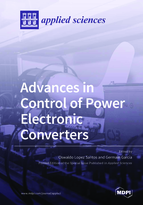Advances in Control of Power Electronic Converters
A special issue of Applied Sciences (ISSN 2076-3417). This special issue belongs to the section "Energy Science and Technology".
Deadline for manuscript submissions: closed (20 January 2021) | Viewed by 19605
Special Issue Editors
Interests: control of power converters; power electronics; photovoltaic solar energy; microgrids and engineering education
Special Issues, Collections and Topics in MDPI journals
Interests: power converters; electrical and electronics engineering; control theory; feedback control; control systems; controller design; nonlinear control; power systems
Special Issues, Collections and Topics in MDPI journals
Special Issue Information
Dear Colleagues,
The relevance of power converters in energy processing applications has growth in the last years with the proliferation of photovoltaic and wind generators, microgrids, electric vehicles and DC distribution systems, among others. This breakthrough has gone hand in hand with development and application of control techniques and the development of performant digital devices in which they can be embedded. Altought classic control techniques have demonstrated to be well established in power electronics industry for many years, recent contributions have helped to improve the performance of these techniques putting in evidence several opportunities. Furthermore, application of advanced control techniques have demonstrated to be powerfull exploiting additional features of the converters improving efficiency, robustness, dynamic performance, simplicity, reliability, flexibility and power density.
One of the main challenges in this field is to provide control laws ensuring a safe and performant operation of the converters in wide ranges of input voltage and output power trying to guarantee a high quality behavior in the entire range despite of uncertainities in the parameters of the system model. Another important challenge is to develop control strategies allowing a single device to operate in different modes facilitating its integration in different power systems. This is the case of converters as part of microgrids which can operate either into a stand-alone mode feeding DC or AC loads or allowing interchange of energy between DC and AC power distribution buses.
The aim of this special issue is to provide a means of interaction between power electronics and control specialist communities which compile the state of the progress in the control of power electronic converters from theory to real implementation. We expect contributions related but not limited to the development or improvement of linear, nonlinear and intelligent control techniques.
Prof. Dr. Oswaldo Lopez Santos;
Prof. Dr. Germain García;
Keywords
- Power electronic converters
- DC-DC converters
- DC-AC converters
- AC-DC converters
- Nonlinear control
- Microgrids
- Intelligent control
- Hybrid control
- Robust control







